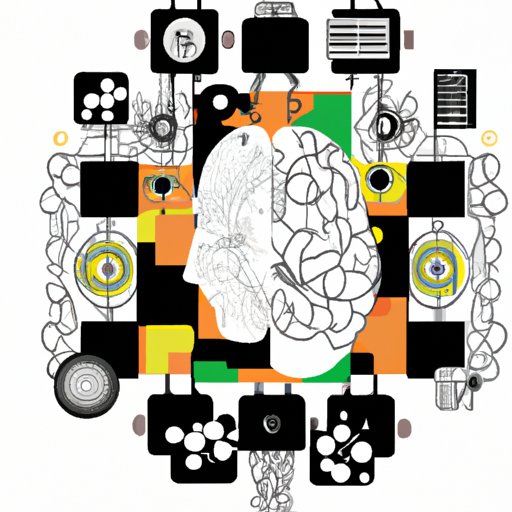Introduction
Artificial intelligence (AI) is a broad term used to describe machines that can think, learn, and act like humans. The concept of AI has been around for centuries; however, it wasn’t until the 1950s that the first serious attempts at creating AI began. In this article, we will explore the history of AI, from its early concepts to modern applications.

Section 1: A Historical Overview of the Development of AI
The concept of AI dates back to ancient Greek mythology. The myth of Talos, a bronze man created by Hephaestus, is one of the earliest known references to AI. However, it wasn’t until the 1950s that the modern concept of AI was developed.
In 1950, Alan Turing published his seminal paper “Computing Machinery and Intelligence,” in which he proposed the Turing Test as a measure of machine intelligence. This paper marked the beginning of the modern era of AI research. In 1956, a group of researchers gathered at Dartmouth College to discuss the possibility of creating a machine that could think. This meeting is widely considered to be the beginning of modern AI research.
In the 1960s, researchers began to develop programs that could play simple games such as chess and checkers. This led to the development of game-playing algorithms, which would eventually become the basis for many AI applications. In the 1970s, researchers began to focus on developing methods for teaching computers how to understand natural language. This led to the development of natural language processing (NLP) systems, which are still used today.
In the 1980s, AI technologies began to be used in a wide range of applications, from medical diagnosis to robotics. This period saw the emergence of expert systems, which are computer programs designed to emulate the decision-making process of human experts. Over the years, AI technologies have become increasingly sophisticated and are now used in many different areas, including autonomous vehicles, facial recognition, and virtual assistants.
Section 2: The Evolution of AI: From Early Concepts to Modern Applications
AI technologies have evolved significantly since their inception in the 1950s. Early AI systems were limited in scope and relied heavily on pre-programmed rules and instructions. However, advances in computing power and the development of new algorithms have enabled AI systems to become increasingly sophisticated. Today, AI technologies are used in a wide range of applications, from medical diagnosis to autonomous vehicles.
One of the main challenges facing AI researchers is teaching machines how to learn and understand complex tasks. This requires the development of algorithms that can recognize patterns and make decisions based on that data. Deep learning is a type of machine learning algorithm that has recently emerged as a powerful tool for AI research. This technology uses neural networks, which are inspired by the structure of the human brain, to analyze large amounts of data and make predictions.
Another challenge facing AI researchers is the development of ethical guidelines for AI technology. As AI becomes more prevalent in our lives, it is important to ensure that these technologies are used responsibly and ethically. Researchers are developing guidelines and frameworks to help ensure that AI technologies are used safely and fairly.

Section 3: How AI Has Shaped Our Lives Over Time
Throughout its history, AI has had a profound impact on our lives. From making medical diagnoses to driving cars, AI technologies have changed the way we live and work. AI has also had an effect on our relationship with technology. As AI becomes more sophisticated, it is becoming increasingly integrated into our lives. We rely on AI to make decisions, provide recommendations, and even interact with us socially.
AI has also had an effect on our understanding of human intelligence. AI technologies are often compared to human intelligence, and researchers are exploring ways to bridge the gap between the two. AI technologies are being used to create systems that can learn and adapt like humans, and this research could lead to a better understanding of human intelligence.
Finally, AI has had an impact on the economy. AI technologies have enabled businesses to automate processes, reduce costs, and improve efficiency. This has resulted in increased productivity and economic growth. AI is also being used to create jobs, and many companies are investing in AI technologies to remain competitive in the marketplace.
Conclusion
In this article, we explored the history of AI, from its early concepts to modern applications. We examined the evolution of AI over time and how it has shaped our lives. We also discussed the impact of AI on human life, our understanding of human intelligence, and the economy. Finally, we explored the challenges facing AI researchers, such as developing ethical guidelines for AI technology and teaching machines how to learn and understand complex tasks.
(Note: Is this article not meeting your expectations? Do you have knowledge or insights to share? Unlock new opportunities and expand your reach by joining our authors team. Click Registration to join us and share your expertise with our readers.)
